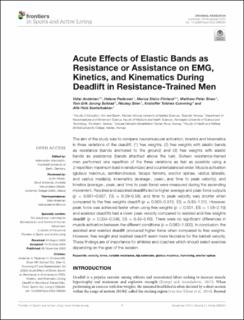| dc.contributor.author | Andersen, Vidar | |
| dc.contributor.author | Pedersen, Helene | |
| dc.contributor.author | Fimland, Marius Steiro | |
| dc.contributor.author | Shaw, Matthew Peter | |
| dc.contributor.author | Solstad, Tom Erik Jorung | |
| dc.contributor.author | Stien, Nicolay | |
| dc.contributor.author | Cumming, Kristoffer Toldnes | |
| dc.contributor.author | Sæterbakken, Atle Hole | |
| dc.date.accessioned | 2021-04-16T09:30:54Z | |
| dc.date.available | 2021-04-16T09:30:54Z | |
| dc.date.created | 2020-10-23T11:07:44Z | |
| dc.date.issued | 2020 | |
| dc.identifier.citation | Frontiers in Sports and Active Living. 2020, 2:598284. | en_US |
| dc.identifier.issn | 2624-9367 | |
| dc.identifier.uri | https://hdl.handle.net/11250/2738065 | |
| dc.description.abstract | The aim of the study was to compare neuromuscular activation, kinetics and kinematics in three variations of the deadlift: (1) free weights, (2) free weights with elastic bands as resistance (bands anchored to the ground) and (3) free weights with elastic bands as assistance (bands attached above the bar). Sixteen resistance-trained men performed one repetition of the three variations as fast as possible using a 2-repetition maximum load in randomized and counterbalanced order. Muscle activation (gluteus maximus, semitendinosus, biceps femoris, erector spinae, vastus lateralis, and vastus medialis), kinematics (average-, peak-, and time to peak velocity), and kinetics (average-, peak,-and time to peak force) were measured during the ascending movement. Resisted and assisted deadlifts led to higher average and peak force outputs (p < 0.001–0.037, ES = 0.29–0.58), and time to peak velocity was shorter when compared to the free weights deadlift (p = 0.005–0.010, ES = 0.83–1.01). However, peak force was achieved faster when using free weights (p < 0.001, ES = 1.58–2.10) and assisted deadlifts had a lower peak velocity compared to resisted and free weights deadlift (p = 0.004–0.046, ES = 0.43–0.60). There were no significant differences in muscle activation between the different conditions (p = 0.082–1.000). In conclusion, the assisted and resisted deadlift produced higher force when compared to free weights. However, free weight and resisted deadlift seem more favorable for the barbell velocity. These findings are of importance for athletes and coaches which should select exercise depending on the goal of the session. | en_US |
| dc.language.iso | eng | en_US |
| dc.publisher | Frontiers Media S.A. | en_US |
| dc.rights | Navngivelse 4.0 Internasjonal | * |
| dc.rights.uri | http://creativecommons.org/licenses/by/4.0/deed.no | * |
| dc.subject | velocity | en_US |
| dc.subject | force | en_US |
| dc.subject | variable resistance | en_US |
| dc.subject | hip extension | en_US |
| dc.subject | gluteus maximus | en_US |
| dc.subject | hamstring | en_US |
| dc.subject | erector spinae | en_US |
| dc.title | Acute Effects of Elastic Bands as Resistance or Assistance on EMG, Kinetics, and Kinematics During Deadlift in Resistance-Trained Men | en_US |
| dc.type | Peer reviewed | en_US |
| dc.type | Journal article | en_US |
| dc.description.version | publishedVersion | en_US |
| dc.rights.holder | Copyright © 2020 Andersen, Pedersen, Fimland, Shaw, Solstad, Stien, Cumming and Saeterbakken. | en_US |
| dc.subject.nsi | VDP::Medisinske Fag: 700::Idrettsmedisinske fag: 850 | en_US |
| dc.source.volume | 2 | en_US |
| dc.source.journal | Frontiers in Sports and Active Living | en_US |
| dc.identifier.doi | 10.3389/fspor.2020.598284 | |
| dc.identifier.cristin | 1841768 | |
| dc.source.articlenumber | 598284 | en_US |
| cristin.ispublished | true | |
| cristin.fulltext | original | |
| cristin.qualitycode | 1 | |

